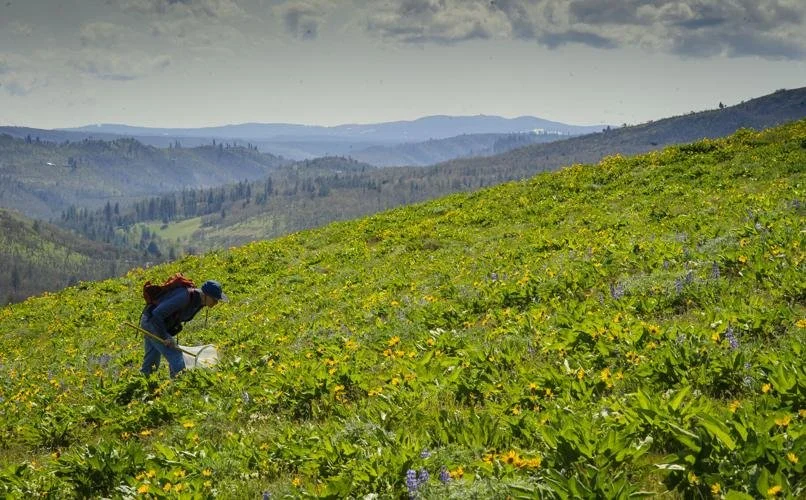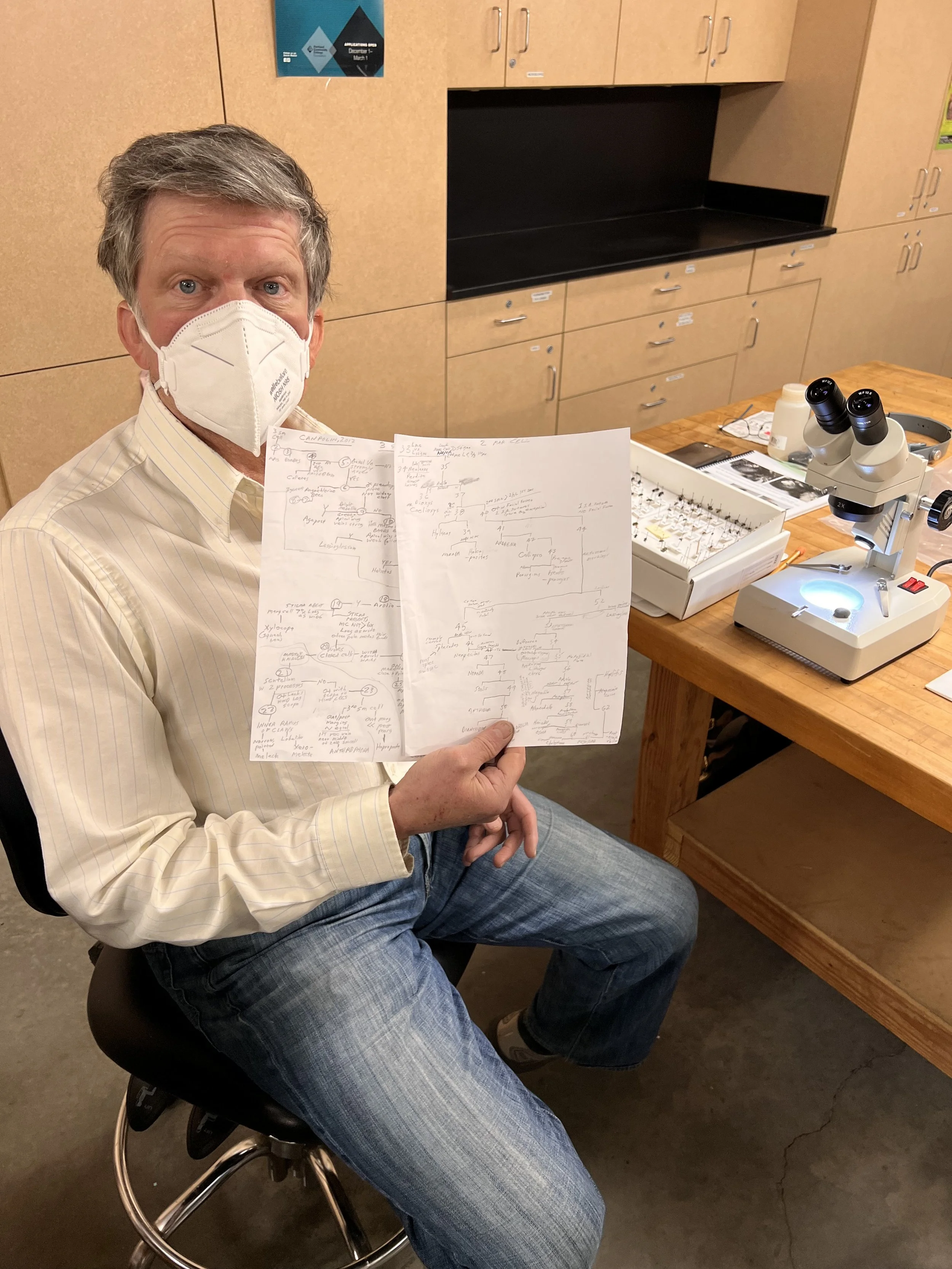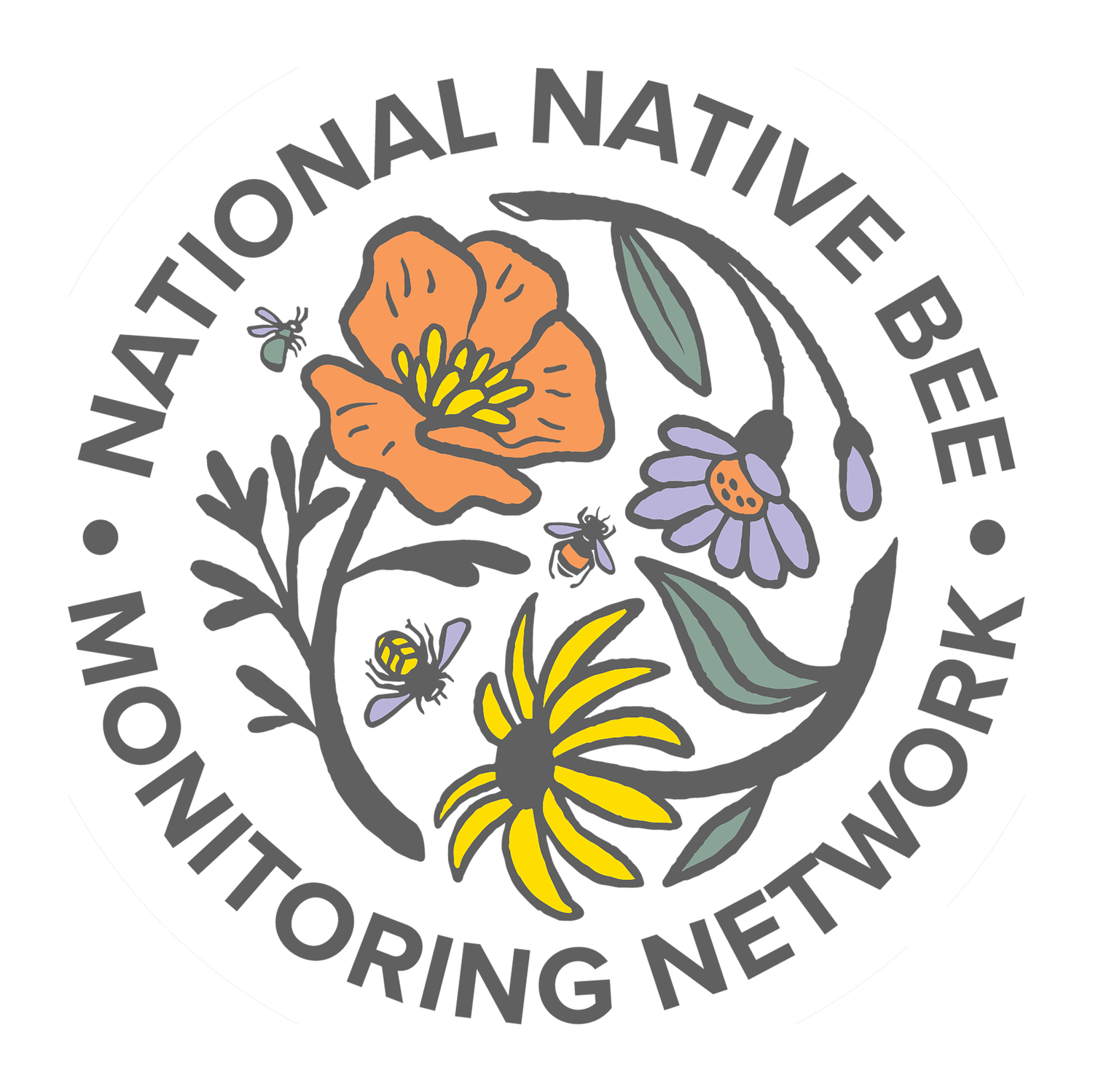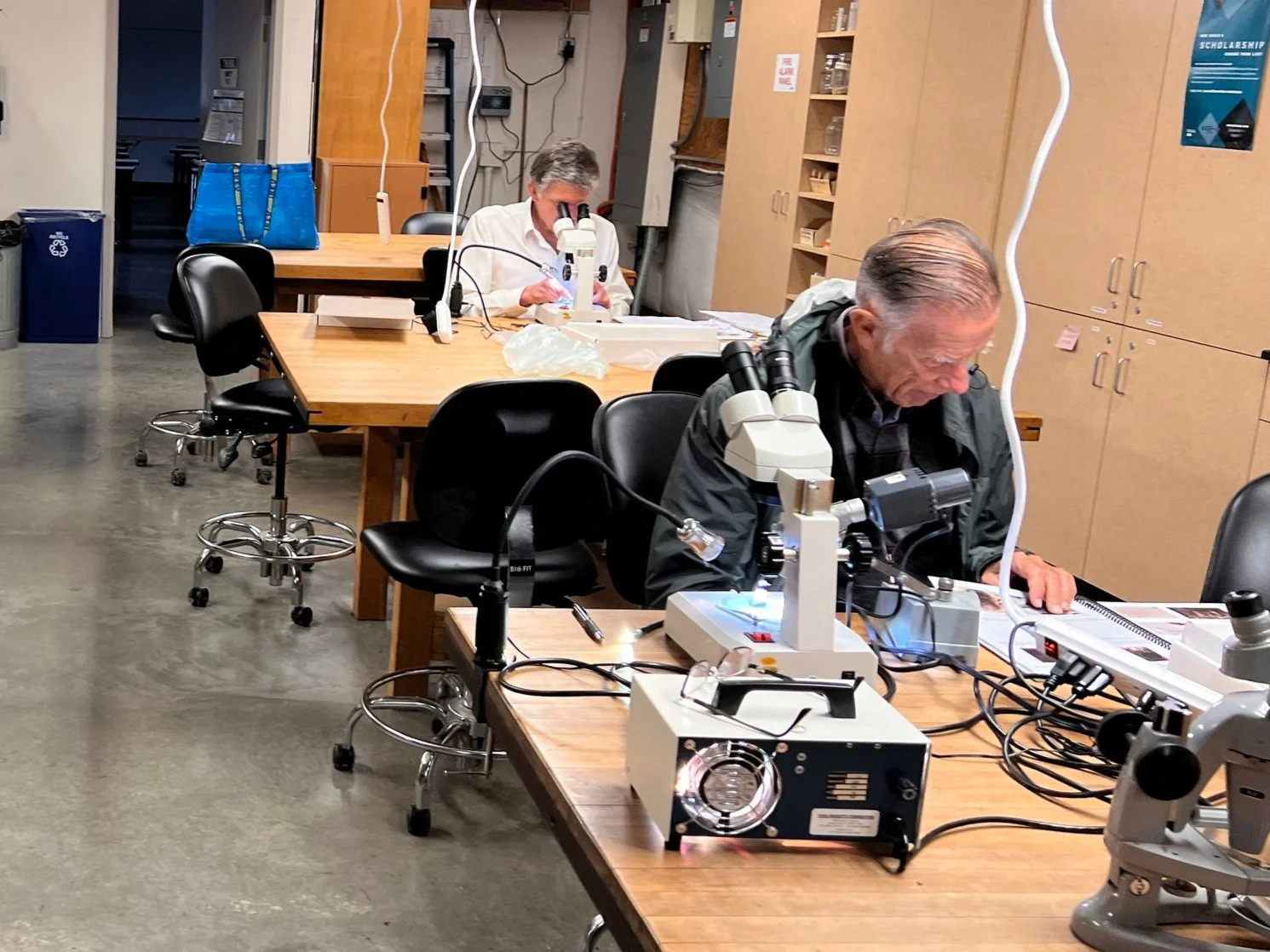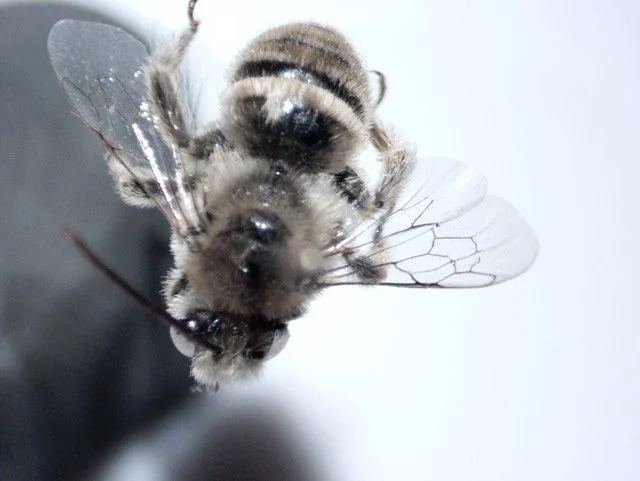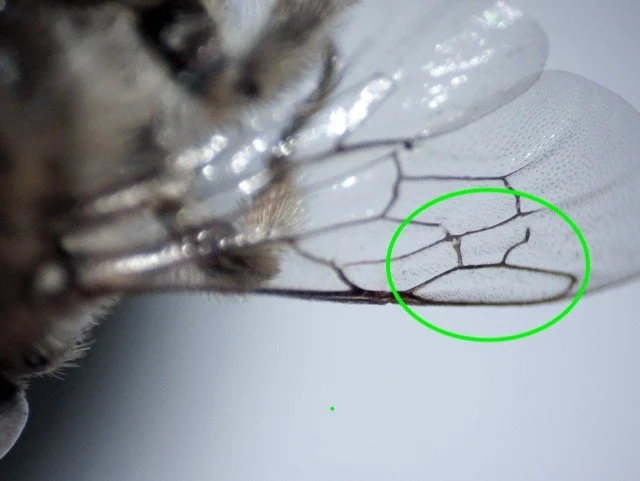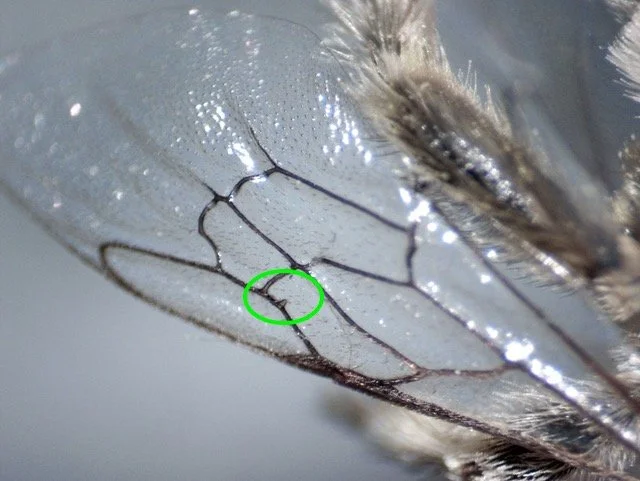As bee ID season gets into full swing, I’m reminded how fun it is to learn. At least that is what I keep telling myself as I stumble onto yet another taxonomic term that I have to look up. I hope you, too, are all enjoying learning new bee-related things as you do outreach, peruse iNaturalist records, or work on identifying your specimens. Check the calendar and watch for Jen’s emails for more opportunities to do so.
If you have any feedback or submission for Field Notes or if you want to post notes for your regional team contact Ellen Silva (e.silva@comcast.net). Please try and get your submissions in the Monday before publication.
In this issue
Field Notes
tool time with the portland team
The PDX team has been having small turnouts at their microscope days thus far (see below for more info on how you can participate), but that doesn’t mean that a lot of learning and sharing isn’t happening. Here is an assortment of identification tools in use at the last event.
Mike Bogar has converted his key to a flow chart — no page flipping!
Mark Gorman has sliced and diced an e-version of Bumblebees of North America to create a concise reference for color morphs of the Oregon species. And it’s laminated!
Bruce Adams uses fiber optics to put the light EXACTLY where he wants it!
Learn About a National Approach to Monitoring Native Bee Populations
The Native Bee Monitoring Network is meeting regularly to develop a broad strategy for conducting wild bee monitoring on a national scale. The workshop presentations have been archived on YouTube, including a session on the Oregon Bee Atlas. But you can also sign up to participate in future workshops. Share your experience as a melittologist who is actively contribute to a state initiative.
Check out the other workshops on their site, including a link to the Bee Short Course for Community Scientists of the OSU Bee Lab (the OTHER OSU - Ohio State. (I know some of you are saying that I’ll get in trouble for not saying THE Ohio State University, but I’m an alum so they’d rather ask me for donations than chastise me for improper trademark use.))
Improved Pollinator Seed Mix Packets Available
Andony has tapped his connections and the most current pollinator seed selection science to bring us a new seed mix tailored for the Willamette Valley. Packets are available for hand outs at outreach event; contact Jen to request some.
New! And Improved! And available for your public outreach events and your own backyard! Read more about the science of this mix HERE.
OBA announcements
Catch a Buzz
Catch a Buzz is November 1 at 7pm. To join, go to https://oregonstate.zoom.us/j/97230252365?pwd=TURyTXNMZ1M5SHl2TFQvajBxemtRdz09 | Password: bees
Next month, Catch a Buzz will be December 6th - add it to your personal calendar now!
The New Module is Here! The New Module is Here!
Yes - Module 6 now has been updated and completed. Those of you who are working on identifying your bees will appreciate the video on reporting your determinations, and even if you aren’t taking your bees to genus or species ID, the video on curation is valuable for anyone turning in a collection. Check it out on Canvas. Remember, following the guidelines in these videos makes our data more accurate while it also reduces the workload on staff, so please review the new content soon.
The date for the annual conference has been set: March 5, 2023. More info to come!
Supply and Presentation Requests Welcome
Do you need a spare box or two for sorting? You can request more supplies by using this form or by contacting Jen via email.
Don’t forget that there are a number of excellent presentations already prepared for our outreach use. Check in with staff to see what’s available for use and adaptation in your events.
Calendar
Catch a Buzz happens the first Tuesday now - that’s the first day of the month for November! Watch for microscope days in various locations around the state.
Team news
If you want to include your own team’s news in the Roundup, send it to Ellen Silva (e.silva@comcast.net) the Monday before we publish (typically, the 1st week of the month).
PDX
Focus, focus, focus.
We are now holding semi-regular microscope days at the Portland Community College Rock Creek Campus. RSVP’s are necessary so we know how many experienced members to have on hand to help. Details come out in reminders the week before the event. If aren’t already receiving email announcemetns about these but you’d like too, please contact Ellen Silva.
Currently scheduled dates:
November 12, 19
December 10, 17
Cool stuff WE have found
The list of intriguing discoveries that OBA volunteers have documented grows ever longer. We’ll feature one here each issue, at least until the flowers return and “What’s In Bloom” returns to this space.
Melissodes sp. collected by Mike Bogar
Searching for bees late in the season paid of for Mike Bogar when he caught this Melissodes in the Bend area on October 10. He couldn’t quite get it to key out to the proper genus, though, because it only had 2 submarginal cells (SMC), and Melissodes have 3 SMC’s. But take a close look at the cells on this bee: the left wing SM cells aren’t even properly closed, hinting at a wing vein deformation. On the right wing, there is a nubbin of a vein right where the missing division would need to be.
Spotting oddities like this is an important part of what we contribute to the science of melittology. Keep up the good work, team!
miscellany (not to be missed)
Catch a Buzz Summary (Martha Richards) - October AND November editions!
NOVEMBER
Microscope Trainings: There are multiple microscope trainings coming up this month, so remember to check the calendar on Canvas and RSVP to an event near you. Bonnie Zand will be leading an online training on November 12th where she will have a camera on her microscope and will be able to move bees around and take questions about what people are seeing. Andony and Linc both heartily endorsed Bonnie's online trainings and being very helpful and informative, so if you don't live close to an in-person training, this is an excellent option.
Determinations: Andony has updated Canvas to include a page with the process for bee determinations. This page also includes a link to the long-awaited Module 6, which provides more details about the determination process. If you want to print your own determination labels, this page includes a file to make that easier. This is also where you will find the downloadable Excel file for entering your bee determinations.
OBA Conference: The 2023 OBA Conference will be held on Sunday, March 5th at OSU. The keynote speaker will be Sandy DeBano, who has done extensive studies on sampling and who has the largest collection of bees in the northeastern part of the state.
Journey Level: The OBA staff are developing the tests for the OBA Journey level with an expected launch date of January 1st. One test will be a series of questions about Solitary Bees by Danforth, so Sara plans to host a study group to discuss the book and explain details that may be unclear. This test will be online and people will have ample time to consider the questions and provide detailed answers. The other test will require identifying ten bumblebees to the species level and 20 bees to the generic level. This test will be in-person, with locations and schedules to be determined.
Linc's Update
Funding is in place for DNA barcoding of approximately 2,000 bees, so Linc and his team have been busy preparing those samples. The focus will be on solitary bees of the sagebrush biome.
Big Bumblebee Ecology News: Linc and USFWS staff found and unearthed a Bombus occidentalis nest in October. B. occidentalis (aka the Western Bumblebee) is a species under consideration for listing due to its declining population, and the Xerces Society and USFWS had been looking for nests on Mount Hood this summer, but without success. Linc directed the group to a different site where they quickly spotted a worker go into a hole in the ground. Once they found the location of the nest, USFWS staff returned a few times to observe activity around the nest and decided to excavate it in October -- after the hive had produced its new queens but before predators moved in to eat the nest remains. They collected the nest as well as associated materials and about a dozen worker bees, and everything is currently in various labs being closely examined and documented. The data they are gathering from this nest will help answer many bumblebee questions - what a find!
Mariposa Reserves: The BLM has a grant for conducting pollinator surveys in Mariposa Reserves, a BLM property near the California border just west of I-5. Linc is planning to offer survey work up to some dedicated OBA members - maybe even you? Watch for more information to come.
License Plate: The bee license plate is almost ready for pre-sales! We will need to pre-sell 3,000 plates before the State will start manufacturing the plates. As soon as the last few details are ironed out, you can go to this page and obtain a voucher for a plate: https://agsci.oregonstate.edu/home/oregon-pollinator-license-plate-presale. This website also explains the costs, details where the funding will be directed, and introduces Marek Stanton, the plate's artist. Once we sell 3,000 vouchers, plates will go into production. Andony is also preparing paper handouts and tablecloths to publicize the plates at public outreach events and will distribute them once pre-sales have begun.
OCTOBER
Microscope Sessions/Training: It's microscope season and there are multiple microscope sessions in various places, so be sure to keep an eye on the calendar on Canvas. There are also some upcoming lab training sessions in Corvallis where participants will work through the identification couplets with a set of bees -- if you're new to the OBA or just need a bit of a refresher, do sign up. Andony is working with Bonnie Zand to set up a remote training lab for those of you who are far from Corvallis.
Module 6 is not done yet. But it will be done very soon. Andony promised. (Ed. note: He kept his promise. It’s done!!!)
Determination Labels: they're now optional! If you are identifying your bees, you are still required to enter your determination in the Portal (either directly or with the spreadsheet system), but you do not need to put the determination label on the bee if you don't want to do that. Determination labels will be available to those who want them. Remember, identifying your bees is not a requirement, but it is highly recommended as a way to enjoy your bees even more.
Seed Mix: There is a new Grumpbee seed mix coming out. Andony worked with a number of other people and took advantage of some recent studies on pollinator seed mixes to come up with a new and improved mix that's tailored for the Willamette Valley. His coordination found that the key to a successful pollinator mix is to have a good balance between annuals (25%), short-lived perennials (50%) and long-lived perennials (25%), which the new mix has, so it's likely to look good for multiple years.
OBA Annual Conference Date: Sunday March 5th, 2023 at OSU. Mark your calendar!
Thanks to Michael O'Laughlin, the OBA was recently awarded NW Natural's Conservation Champion Catalyst Award, which comes with $10,000!
Melittology quizquillia: What's that, you ask? It's a brand-new feature of the Catch a Buzz meeting, where anyone is welcome to sign up and give a short -- 10 minutes or so -- talk about a monograph or study you've recently read. If you're interested, drop Andony a line. This month's presentation was on Catherine Cumberland's monograph, "Principal Sunflower Bees of North America with an Emphasis on the Southwestern United States" published in California Entomology. It's available in the taxonomy folder, along with other CA Entomology monographs. Give it a read! Andony found out about the article when he and Linc recently attended the 5th workshop of the National Native Bee Monitoring Network.
Taxonomy Update: We have discovered another new genus for the state of Oregon -- Micralictoides! Three OBA members visited the Rough and Ready Botanical Wayside near OR 199 just north of California and each caught one or two of these bees on Eschscholzia californica (California poppy). They're small bees, black with a red abdomen, and they look similar to Dufourea, but have a shorter face. The bees were all M. ruficatus, and Linc plans to mount some expeditions in the vicinity to learn more about the bee's range and where it gets its nectar from, as E. californica produces only pollen and no nectar.
Collecting Updates: There were a number of reports of recent collecting successes off of Ericameria (rabbitbrush) in various parts of the state. Expect to get up to five different species of Colletes and possibly some Triepeolus or Epeolus from rabbitbrush, says Linc. Baccharis pilularis (coyote bush) is also a good late-season nectar source.
License Plates: The new Oregon license plate is very close to getting approved for sale! It's now close enough to being approved that it's okay to start spreading the word. Andony is having some license plate advertisement tablecloths printed for outreach events.
Public Presentations: If you're planning to give a public presentation about the OBA, be aware that the OBA staff have a number of presentations, images, and slides available for your use -- just ask any of the OBA staff members.
The Advisory Committee is made up of a revolving set of OBA members and exists to advise the OBA staff and act as a sounding board for new ideas (thanks for all you do!). There's now a link on Canvas to the inner workings of the committee, including committee member bios, contact information, meeting minutes, and the 2021 Strategic Plan.
OBA featured in Columbia Gorge News
Flora Gibson, writer for the Columbia Gorge News, recently finished a series of four wonderful articles describing our collecting efforts in the Gorge. They are well worth a read, and a great way to share what we are doing with family and friends. See them all HERE.
It’s hard to find a prettier place than the Gorge in early spring.
